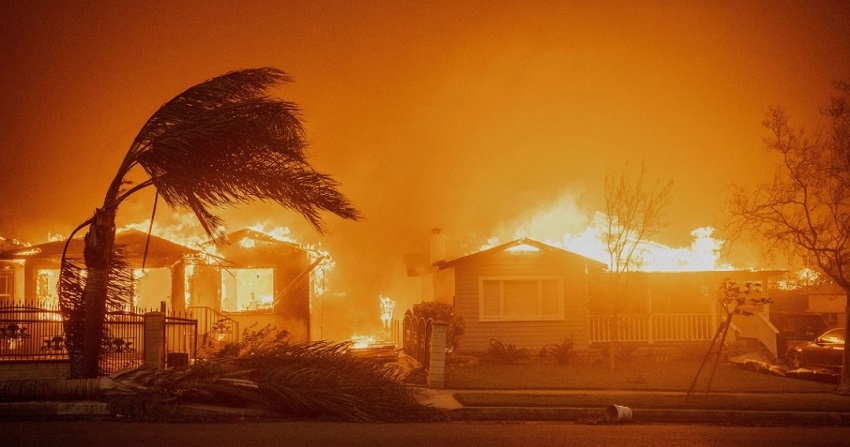At the beginning of 2025, world news media were awash with a series of wildfires in the US, southern state of California, specifically in the Greater Los Angeles area, that caused at least 28 deaths, thousands of destroyed structures, evacuations centers and widespread power outages in January.
The timing of “fire season” in California is variable, depending on the amount of prior winter and spring precipitation, the frequency and severity of weather such as heat waves and wind events, and the moisture content in vegetation. California typically sees wildfire activity between late spring and early fall, peaking in the summer with hotter and drier conditions.
According to climate scientists, climate change increased the likelihood of the event by creating first a very strong rainfall (which resulted in more vegetation), and then a very strong drought (which dried the vegetation). Climate change also increases the intensity of winds, and reduces the amount of water available for stopping the wildfires. It is also important to note that Extreme weather events such as wildfires are becoming more severe and frequent because of pollution caused by burning gas, coal, and oil. This traps heat and directly contributes to Earth’s overheating, with the impact not confined to just wildfire-prone areas.
The US California wildfires wildfires destroyed houses of some of the richest people in California, including many homes in Malibu’s Carbon Beach, colloquially also known as “Billionaire’s Beach”. The estimated cost of these wildfires is about 250 to 275 billion US dollars. The economic damage caused by these wildfires could become one of the worst natural catastrophes the United States has experienced. Hurricane Katrina was a powerful, devastating tropical cyclone although caused more fatalities than these wildfires (over 1000) its economic damages was estimated at $125 billion in late August 2005, that is about 200 billion (adjusted for inflation) in economic losses.
In our local context, the extent of this damage is 5 times the size of Uganda’s economy translating to about 600 times the Uganda’s insurance industry market. The damage is quite enormous even for the reinsurance markets alike. The ripple effects from California wildfires has far reaching consequences locally for the home owners and beyond including possibly raising the costs in our local reinsurance markets
As insurance companies grapple with the rising costs of natural disasters, they are looking for ways to protect themselves. Actuaries are predicting that the fires could lead to increased homeowners insurance costs, caused by the raising reinsurance hikes from catastrophic losses. Insurance distribution agents in this part of the US market are facing the toughest times in about 2 decades placing covers, with companies raising rates and reducing coverage. Some insurers are excluding coverage for home owners all together.
For the insurance industry, the threat of massive and profoundly destructive wildfires poses a significant and immediate problem — one that could reshape the wildfire market and insurance for other major natural perils. While climate change is causing more powerful storms and hurricanes, big hurricanes — are frequent enough that the insurance industry understands them and can manage the risk well. it’s clear that the current system is going to struggle to contend with increasingly destructive events like this.
Wildfire of the magnitude, that ravaged the Los Angeles area could become the most expensive natural disaster in their history, as well as the insurance industry’s costliest wildfire by a wide margin. While customers need wildfire protection, insurers need to find a new way to provide it.
Hurricanes have over time changed the way insurers looked at them and at natural catastrophes in general. Higher Category 5 hurricanes have caused fatalities, destroyed or damaged homes, and cost insurers billions, and losses have led to the failure of insurers. The combination of financial losses and insurance-company failures signalled the need for radical change, ultimately leading to insurance industry’s use of more sophisticated analytics and modelling, especially in the face of catastrophic events.
Improved analytics helped insurers understand how much risk they could hold and where they would benefit from risk transfer, with reinsurers then helping to spread highly concentrated risks to a broader pool of capital.
With the lessons from Hurricanes, insurers became more resilient — and more reliable. Parametric insurance bridges the gaps in traditional insurance coverage, which insurers need to be able to help businesses exposed to such natural threats. Instead of changing approved rates or withdrawing protection for certain risks (like wildfire).
This niche form of protection has gained relative popularity in regions where major perils have made it difficult for insurers to provide full protection. Parametric insurance pays a predefined amount out when a specific type of event reaches a predefined magnitude rather than the actual loss incurred. Insurers know how much they’re going to pay out, customers know how much they’re going to get, and the conditions for when payments are made are clear. Companies in the Caribbean and in the Gulf of Mexico have used parametric insurance to get hurricane coverage where their original insurance policy either excludes it or only provides a small amount of protection. It’s also common for earthquake insurance in places like Istanbul, California, and Japan.
Now it is poised to become the most important insurance tool following the wildfire disaster which unfolded in the Los Angeles area, but also for businesses in California that are worried about wildfire — or more broadly, any business exposed to natural catastrophe risk in general. Parametric insurance moves away from traditional insurance in the sense that it focuses on the peril, instead of a claim being based on how much damage a hurricane or earthquake does to a house or office tower, so it will pay out based on the magnitude of the event. If the natural peril is covered and say wildfire, earthquake, or hurricane — reaches the necessary thresholds, the policy pays out. Otherwise, it doesn’t.
There are two core elements to the coverage. First is the event. The policy will pay out as long as; say an earthquake in your area exceeds a certain level, like 7.0 on the Richter scale. Second, the insurer will want you to show that you’ve sustained some damage. This is to make sure the insurance policy works properly, and doesn’t pay you when you’ve had no financial impact. Parametric insurance has helped with the shortage of say earthquake protection in other places exposed to natural disasters, from Florida to Japan and beyond.
Parametric policies have become an important tool for businesses seeking protection against such catastrophic events in these prone areas and If wild fires ultimately prove to be catastrophic then demand for this form of risk transfer could be poised to grow significantly.
Shopping for parametric insurance doesn’t have to be difficult, but not all agents and brokers are familiar with it. Consulting a broker with parametric experience makes a difference. Not only will they help you understand the product and determine right parameters, they’ll most likely have relationships with parametric insurers, making the process much smoother, especially for first-time buyers.
In the near term and for our markets here, learning as much as possible and understanding how parametric insurance can fit into a broader insurance programs can streamline the decision-making process down the road. It’s not often that new threats come with available solutions. For businesses in say in California — and anywhere in the world where natural disasters have become difficult to insure — parametric insurance can help fill the gaps in traditional insurance coverage.
It might be new to the next wave of buyers, but the concept has been proven time and again.








Leave a Reply